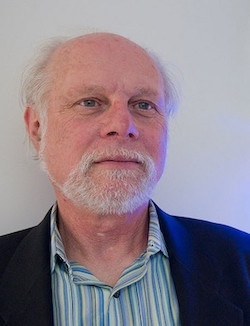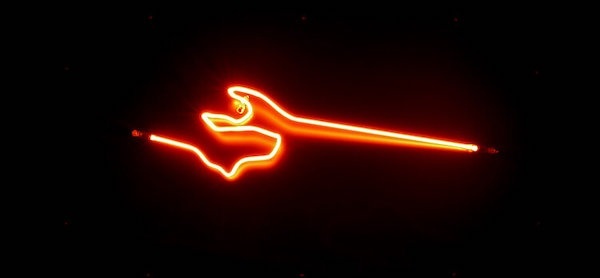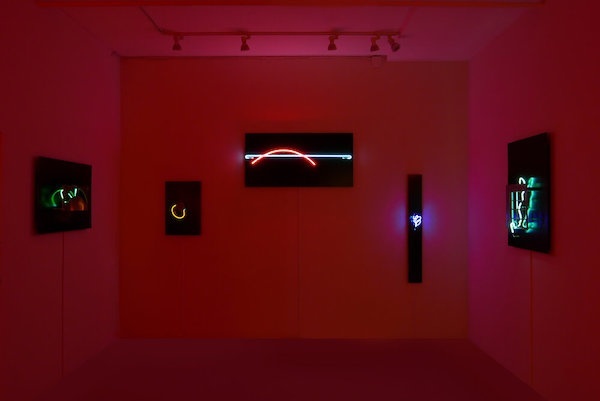Visual Arts Remembrance: Farewell to a Light Artist — John Powell
By Mark Favermann
It seems quite fitting for an artist of light to leave a gallery show filled with his distinctive multimedia light art. Memories of John Powell, like his art, will continue to glow, brightly.
Neon Shadows: John Powell at the Howard Yezerski Gallery , 460 Harrison Avenue, A16, Boston, MA, through March 17.

Old Northern Bridge, lit by John Powell. Photo: Matt Conti for NorthEndWaterfront.com.
Neon Shadows, artwork created by the late light artist and sculptor John Powell, fills a room with neon minimalist “drawings” mounted on pieces of painted metal. Powell’s signature artist statements were environmental works, giant projections of color on bridges and significant buildings. In contrast to these massive and celebrated visions, Neon Shadows features small intense light sketches that reflect the artist’s personal aesthetic, using light as a medium in mixed-media collages mounted on steel plate.
Sadly, Powell died on February 11; he was not able to visit the finished exhibition. Attended by a large crowd, the gallery opening served as an artistic event that was also a fitting memorial. Metaphorically, the show’s title evokes what Powell accomplished over the course of his long career: he brought exhilarating light to urban settings. The exhibition provides a thoughtful, bright illustration of his creative sensibility and his noteworthy technical genius.
In Neon Shadows, Powell shapes light into lines in a variety of joyful, expressive, and sensitive ways. Shapes and colors were major issues in his work. Here, contour drawings are created out of pure light, light as gesture, color as expression. Powell was a thoughtful, highly detailed visual artist, and in this show each piece exudes a careful elegance. He created simple but strong images out of complex mechanical requirements. He stated that his work was built out of planes — often steel or aluminum — that reflected and often incorporated light. Powell continually wrestled with containing pools of light in small as well as large areas. He handily won this aesthetic struggle.

The late John Powell.
Working most of his life as an environmental sculptor, Powell led a career whose journey was long, winding, and highly international. Born in Los Angeles, he said that he spent his high school years chasing trains with a 4 x 5 camera. After college, Powell moved to Idaho, where he built his own studio deep in the Snake River Canyon. He occasionally exhibited his early work, where you could see how he developed technical expertise working with new and repurposed construction materials. For several years he was also employed as a long-haul mover of large artworks from the Western part of the US to galleries and museums on the East Coast.
In the ’80s, John permanently moved to the East Coast. He enrolled in the graduate program at Mass Art and Design in 1984 and received his MFA in 1986. After meetings and lengthy conversations with international maestro Otto Piene, director of the Center for Advanced Visual Studies (CAVS) at MIT, he was accepted into the masters program at the university. Quickly, he became Piene’s teaching assistant and strategic technical consultant. After receiving his degree, he accepted a position as a research fellow, working on holography and spatial imaging until 1993. For decades, Powell served as Otto’s primary technical lead on all of his projects and installations. Over the years, he participated in major CAVS projects in the US, France, Germany, Denmark, and Finland. During his travels, Powell made many long-term international artist friends.
During the ’80s and ’90s, Powell worked on individual commissions and exhibits both at museums and in public art settings. An example of his activity at the time was the installation and illumination of his then studio locale, Thayer Street, which was included (by director David Ross) in the show Boston, Now at the ICA in 1987.
In 1993, Powell started Light Time in Space, Inc. to seriously explore the idea that light could play a major part in public art projects. Some of his consulting work was with GTE Sylvania, which led to projects that used holographic imaging systems to create “flat lenses.” He also worked with other LED and light fixture providers, such as Luminus Devices in Sudbury and Color Kinetics in Burlington, MA. His residencies and installations included work in Holland and Denmark (at the Gammel Doks Center for Art and Craft), which led to his being asked to do some permanent projects for the city of Denver.

Red Line on Black by John Powell, 2019. Neon on polymetal, 24 x 48 in. Photo: Howard Yezerski.
His major installations include illuminating four connecting bridges between Boston and Cambridge for the Charles River Conservancy during the first decade of the 21st century; illuminating the Evelyn Moakley Bridge over Fort Point Channel in 2004; illumination of the Cyclorama Dome in Boston’s South End in 1993; a commission from the New Balance Company to design and fabricate three 24-foot-tall wind-driven zoetropes illustrating the history of the Boston neighborhood Brighton; and a commission to create projections for Harvard Business School’s Innovation Lab’s (ILab) facade at 125 Western Avenue, Allston, in 2011.
More recently, Powell illuminated the Memorial Bridge that connects Portsmouth, NH, and Kittery, ME, and lit up bridges in the Boston neighborhood of Dorchester. Last fall he illuminated prominent structures in Lawrence, MA, including the 267-foot-tall Ayer Mill clock tower, the Casey Bridge, and overpasses, to mark the city’s revitalization. Titled Illuminación, the light show was sponsored by Essex County Community Foundation, the Barr Foundation, and the City of Lawrence. These projects are just a sampling of his extensive portfolio.
As technology’s energy efficiency evolved, so did Powell. He served as consultant to many organizations and companies. He also passionately served on the boards of arts organizations, including LIGHT Boston (illuminating structures and places in Boston) and cultureNow/Museum without Walls (an advocacy group that provides an app for self-directed walking tours of public art and architecture sites in 90 cities).

Installation shot of Neon Shadows by John Powell at Howard Yezerski’s Gallery, Photo credit: Howard Yezerski.
For the past decade, John Powell and I have been close friends. Given our East Coast/West coast differences, we didn’t always agree on issues or even perspectives, but our mutual admiration created a strong bond. Though he could at times be gruff, highly opinionated, and even argumentative, he also was very charming, solicitous, flirtatious with women of all ages, and even quite empathetic. Along with his cherished friends and family, he was admired, even loved, by his many collaborators, artist colleagues, and fellow board members. The loss to the public art community is enormous. He will be greatly missed.
It seems quite fitting for an artist of light to leave a gallery show filled with his distinctive multimedia creations. Memories of John, like his art, will continue to glow, brightly.
An urban designer and public artist, Mark Favermann has been deeply involved in branding, enhancing, and making more accessible parts of cities, sports venues, and key institutions. Also an award-winning public artist, he creates functional public art as civic design. Mark created the Looks of the 1996 Centennial Olympic Games in Atlanta, the 1999 Ryder Cup Matches in Brookline, MA, and the 2000 NCAA Final Four in Indianapolis. The designer of the renovated Coolidge Corner Theatre, he is design consultant to the Massachusetts Downtown Initiative Program. Since 2002, Mark has been a design consultant to the Red Sox. Mark is Associate Editor of Arts Fuse.


This is a fair and balanced treatment of the artist. He was my student in a MASS Art graduate class and we became friends for the years that followed. The questions about his artistic legacy are intriguing and valid.
I loved the guy and all his quirks, parrots, and curmudgeonliness. We worked together on numerous architectural projects, big and small. For examples: He fabricated industrial steel gateways into and through Mitsubishi laboratories, radially curved aluminum shingles for a conical roof, and created a magical steel egress stair that spiraled onto a granite ledge. My wife’s computer sits on a steel desk he built. Our rose trellis rests on his ladder-like pairs columns. The complex hood over our stove is a single piece of stainless steel he precisely bent and folded. My deep regret is that we never worked together on a lighting design.
John Spears